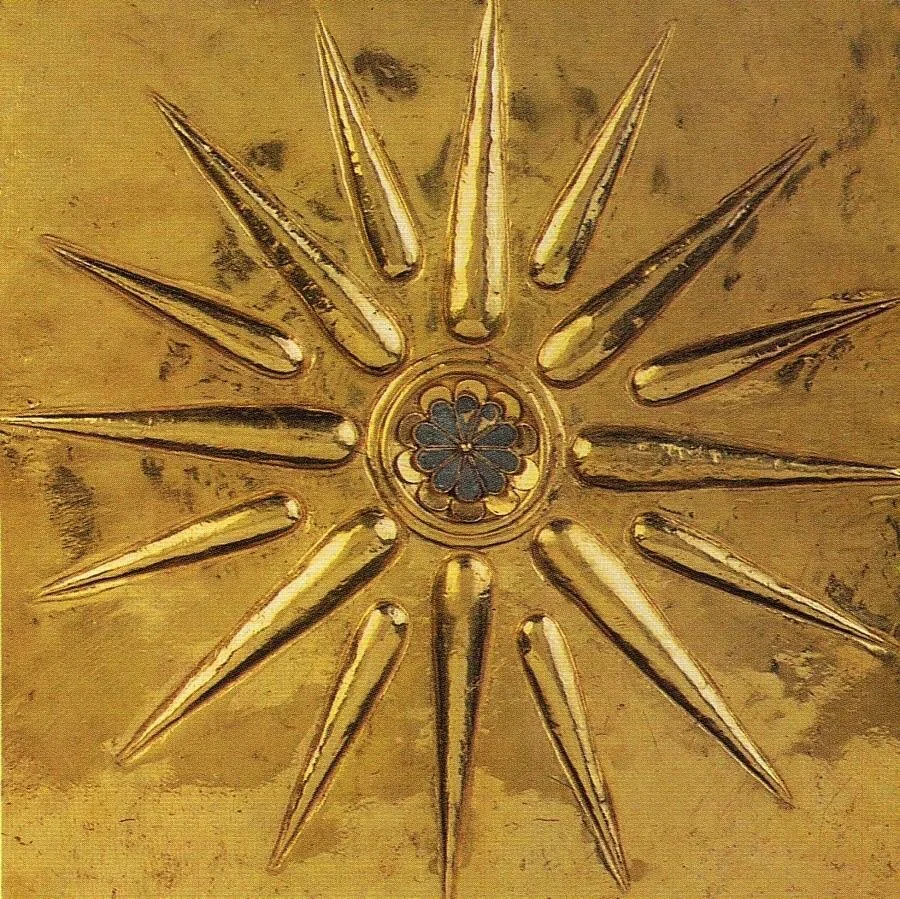Much has been written and told about the much discussed symbol of Vergina. Some call it a star, others call it a sun…
The only sure thing however is that all of them are referring to the same symbol which is depicted on the golden “box” (maybe reliquary), which was found in 1977 by M. Andronikos and is attributed to the Macedonian Royal Dynasty of Philip II.
The golden larnax of Vergina (Archaeological Museum of Thessaloniki)
The symbol of Vergina: its uses & symbolisms in time.
This symbol was already known from the past as a decorative motif. Archaeologists have found it many times on Hellenistic coins, shields, vases, etc.
Such items were found on both the mainland and the islands of Greece. The motif usually had 16, 12 or 8 “rays” and sometimes it was a religious symbol connected with the 12 Olympian gods.
After 1977 it was associated with the Dynasty of Philip and Macedonia. But the Macedonian star or sun has 16 “rays” and in the center is a “rodakas”(=rosette).
‘RODAKAS”: the magic center of everything.
MYCENAEAN ROSETTE-RODAKAS - around 1500 BC
“Rodakas” means “flower” and as a decorative motif it was of particular importance to the ancient Greeks. It symbolizes beauty, purity, eugenics, fertilization, earth. Many royal houses also used it as a symbol of power.
On the symbol of Vergina, a “rodakas” is put in the center and is considered as a symbol of the Earth on which all the material and spiritual goods are fertilized.
History of Rodakas
The rosette (rodakas in Greek) a motif that was widespread throughout Mesopotamia, Egypt and other ancient civilizations appears as well in many ancient Greek-Mycenaean jewels, among its other decorative uses in architecture and pottery from 1500 BC.
Mycenaean rosettes come usually in 6 or 8 or 12 leaves. They were made of gold and were used to decorate cloths for both men and women, sewn directly on them. They were also used in belts or as repeated motifs in necklaces, and as single decorations in earrings and rings.
It is believed that these rosette motifs represent a kind of wild rose, a flower represented in frescoes of this era. Their use in celebration garlands, their presence in rites as offerings in women’s hands and the evidence in the Linear B of Knossos of one “month of the roses” that reflects the idea of a religious celebration, indicate the symbolic meaning of the wild roses and consequently the symbolic meaning of the rosette motif.
The symbol of Vergina: ‘Sun’ or ‘Star’ ?
It is precisely with this element that the shape of the so-called ‘rays’ is connected.
However, these 16 “rays”, as experts say, are not light rays, rays of a star or a sun. The analysts came to the simple conclusion that if this were the case, they would have the typical depiction and close to the center would be thinner and away from the center, wider. Just like the light that spreads and diffuses. At least, this is what typologically can be observed in other depictions of stars or suns. And that would be the ultimate expectation.
Instead, however, the 16 stems look more like comets directed somewhere; and specifically to the center , which is the Earth.
The number (16) is considered to be related to the symbol of totality and completeness. In many cultures, number 16 symbolizes the “totality”.
This complete set/ totality on the symbol of Vergina consists of the fire, the Ocean, the Earth and the Air. These are the four
elements that in ancient times constituted the world and are therefore placed at the edges of two vertical imaginary axes.
In the four quadrants which are created by these vertical axes are placed the 12 gods, who were the centre of worship and faith in Ancient Greece. On the right side we can find all the names of the gods, while on the left all the names of the goddesses.
You can see the explanation in the following animation :
Coins and pottery of different periods and areas, bringing the same symbol.
The sixteen-rayed "Vergina Sun" design on the "Cybele Plaque" from Ai Khanoum, Bactria (3rd century BC). The "sunburst" here represents a star, not the Sun, shown in a star and crescent configuration alongside Helios, who is shown separately in the form of a bust with a rayed halo of thirteen rays.
Ancient Greek coin from Campania, Italy (3rd century BC). A Vergina sun symbol is depicted above the bull.
Achilles and Ajax playing a board game. Eight-pointed sun symbols are depicted on their cloaks. Amphora by Exekias, 6th century BC, Vatican Museum.
Heracles fighting the Amazons. Attic black-figure lekythos, early 5th century BC, from Gela. An amazon bearing a Vergina sun symbol on her shield. Regional Archaeological Museum "Antonio Salinas", Palermo.
A Vergina sun on Athena's shield. Pithos with the Judgment of Paris, from Athens (4th century BC).
Source: Wikipedia - griekse-les.nl




















